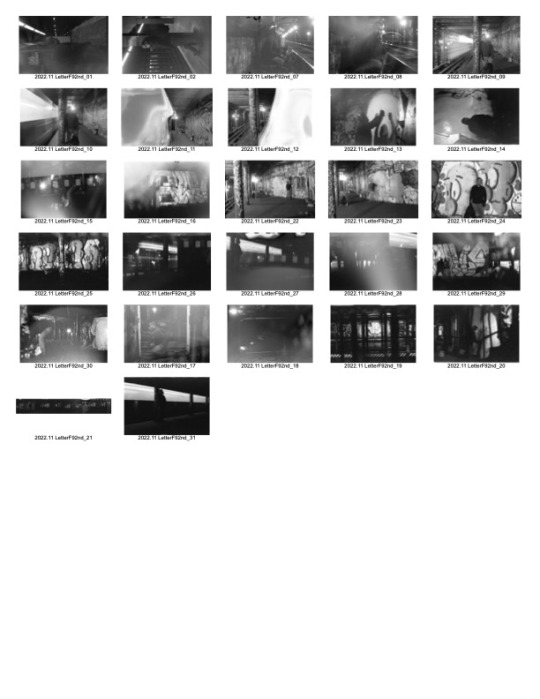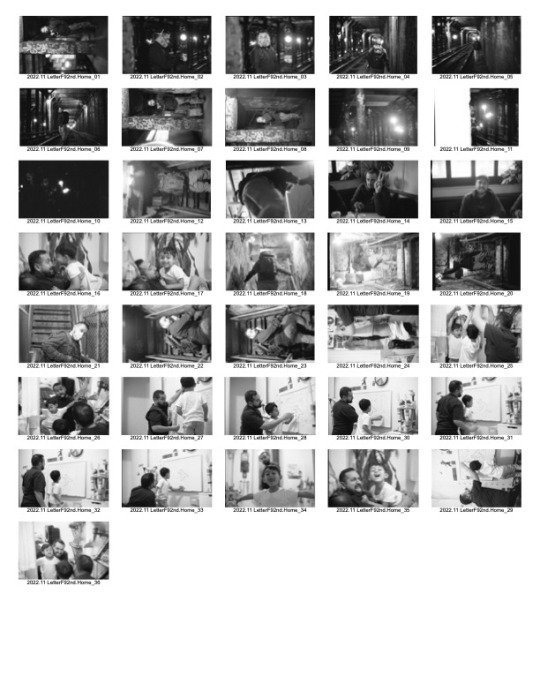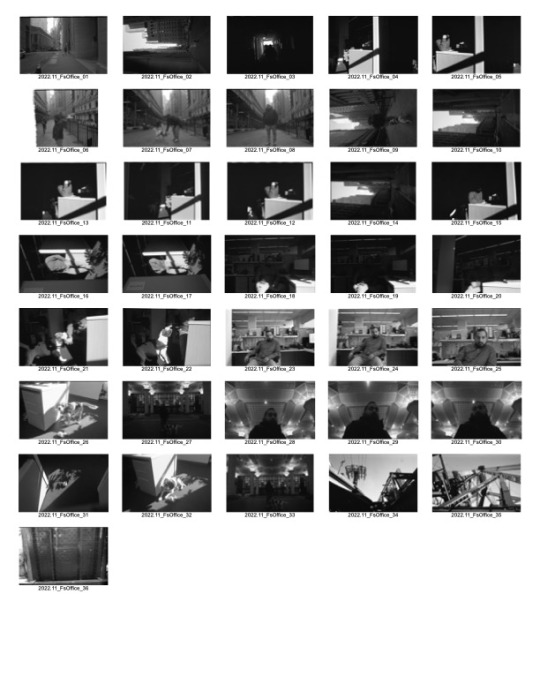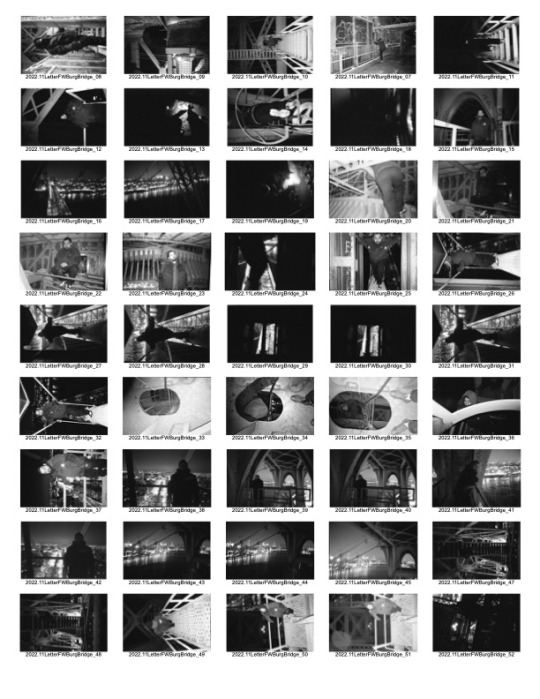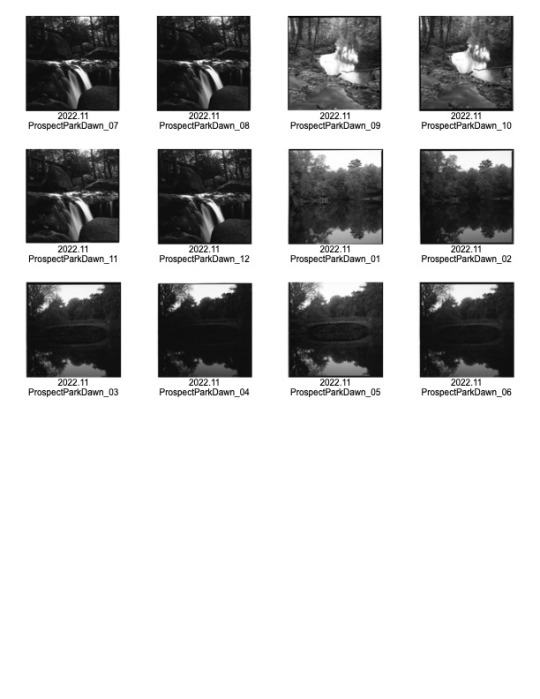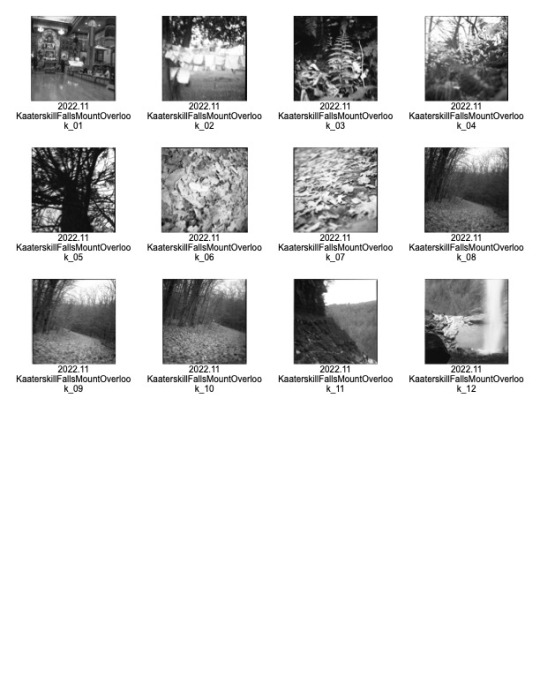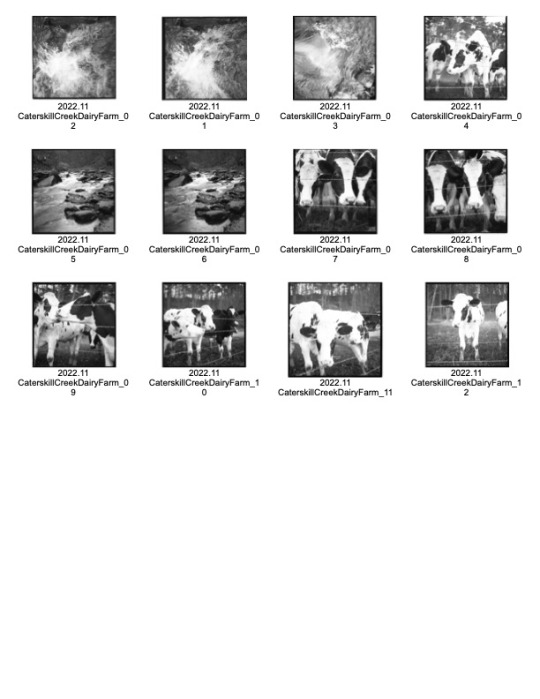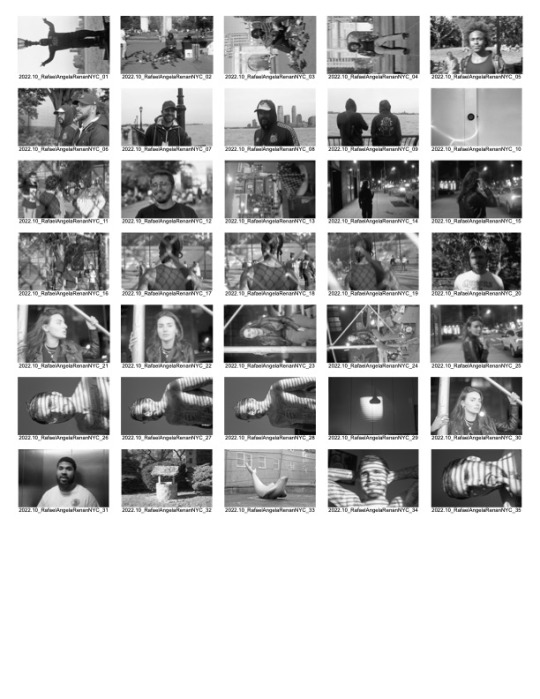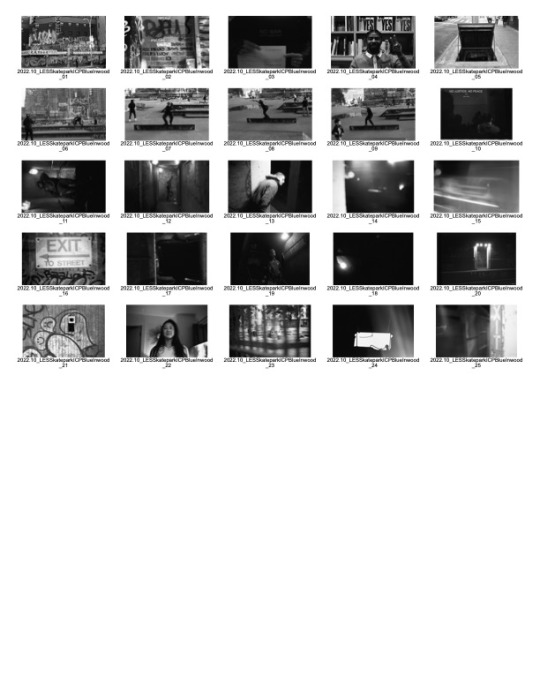Text
Final Project Peer Review by Giulia Armenato
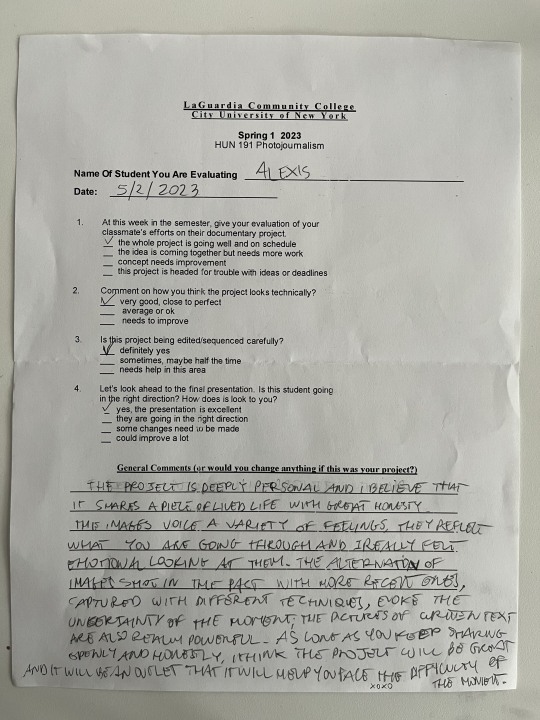
0 notes
Text
Avedon 100 Exhibition
Although the images displayed in the Avedon exhibition are not part of one story, can you discover a narrative interpretation in one or more of the images offered in this exhibition?
One obvious narrative come to mind— the documentation of Jacob Israel Avedon, Richard’s father, throughout his older age and then eventually as he was dying (although the more graphic photos of his dying were not shown at the exhibition).
The photos displayed together in chronological order show the declining health of his father—The first photo at the top shows Richard’s father with a sharp expression in his eyes and dark hair (although to be fair it was most likely dyed); he is an older man but his stature and expression in the photos still demand respect; looking at this photo, I can empathize how he might inspire the type of fear and oppression in Richard that he [Richard] has described in other publications.
As the photos go on this man becomes fragile in his pressed suits—in the two photos with his polka dot tie, the suits seem to fit too big for Jacob; his frame shrinking under his boxed-shouldered topcoat, gray hair and dentures, age spots and wrinkles more pronounced.
The next two photos of Avedon's father in a black suit—the poor man looks like a complete shadow of his former self in the first photo... though his eyes are looking at the camera in the first shot, they seem lost, as if not truly understanding what he is looking at. The second photo seems to confirm his “mentally checked out” ambiguity. The last two photos of Jacob show him in a hospital gown, thinning, frail, and distant. As a viewer, it seems these may be some of the last images that Richard will make of his father who is evidently on his way out...

2. Avedon’s images often blur the lines between the genres of fashion, fine art and documentary photography. Do you feel his work acts as photojournalistic telling stories in single images and or series? Explain your reasoning.
I absolutely feel that Avedon’s work acts as a photojournalistic body of work! His collection is so extensive, it is evident that he was an absolute workhorse and probably shot everyday of his life. In that sense, he really lived by the mantra that “half the job is just showing up”, and by consistently “showing up”, he was able to create a documentation of the times, of “America, then”. Not just simply in his more obvious photojournalistic works, such as In The American West, but even in his fashion and finer art photography of celebrities and high society; those who shaped popular culture for over sixty years, from Marilyn Monroe, to Audrey Hepburn, Cindy Crawford, Chaka Khan, Andy Warhol and other members of The Factory, etc. His Portraits of Power collection of elite government officials, contrasted with the civil rights movement and figures like Martin Luther King, Malcolm X and the Young Lords; his high school friend James Baldwin… these are people that have gone down in American history, some have already passed away, but they were documented and live on in these iconic photos taken by one of the greatest photographers of all time.
Furthermore, there is much than can still be inferred with each photo: the attitudes of the time, style, fashion and beauty standards, social conversations of homoeroticism and sexual liberation, fights for racial equity and socioeconomic liberation, the expansion and construction of America’s Western frontier. Perhaps Avedon was not completely cognizant of these themes at the time of taking these photos, but shown together as a retrospective collective (that I also must mention was largely displayed in chronological order, to its conveyance success) his work functions to tell many stories of the people of the time. Many of his photos are strong enough to tell a story as a standalone, but compiled together, their power and success in storytelling and conveying an era in history is undeniable.
3. Choose 2 remarkably different images from the exhibition. Speak to the similarities and differences between each image. What attracted you to these images?
Two remarkably different photos are the studio portrait taken of Michael Jordan, and the portrait out in the oil field of Tom Stroud in Oklahoma. These images, though completely different, both show their subjects with such a level of dignity, intensity, and both photos focus on their subject by using Avedon’s signature white background—there is nothing that distracts us as viewers from these people.
The use of studio lighting with Michael Jordan makes his dark skin look like black gold in the way that it shines and glistens from sweat in the strobe lights. It is highly complimentary for this rich skin to be placed against the plain backdrop of Avedon's signature white. This shot is a mix of fashion and glamour that Avedon was known for—Jordan wears his iconic Jordan Retro 4 sneakers, that are still highly sought after even today. His socks are perfectly crisp and white, his huge hands in total control of the basketball, the classic Bulls 23 jersey which is also a street fashion/courtside Chicago staple to this day. Michael stands in position with an intense look in his eyes and allows the viewer to feel that they’re on the court with him, about to get their ankles broken in a fatal crossover and be humiliated after he dunks over our heads. There is poise, prestige; he demands respect, even from his small 8x10 print mounted on the wall.
Conversely, the photo of Tom Stroud in the oil field, while still demanding respect, demands so in a much different way. First, the photo must be at least 4 feet tall (from my memory), bringing a sense of prestige and recognition that demands respect for a man that, in reality, might be easily be overlooked given his “lower class” as a laborer. Like Michael, his eyes are piercing and intense, enhanced by their light color and allowing visual texture to be captured in his irises. His skin is filthy, layered with earth and oil from a days work on the field, his shirt is off, his leather vest ripped, hair sopping. The expression on his face is hardened; one can only wonder what his life story is. Though it is clear he’s had a hard life, he is not asking for pity.
Two completely different figures, one famous, one blue collar, and yet both displayed with such dignity; two men from completely different walks of life with such resolve and power in something so subtle as the expression on their faces. The amount of detail captured on both photos truly highlights the resolution capability of 8x10 negatives—the show as a whole was super inspiring as it related to this format (and large format in general). Avedon was a master, and as a student, it was highly inspirational to see so many creative possibilities of using large format cameras/film and furthermore, creative ways as to how these negatives can be printed.


1 note
·
View note
Text
Wall Street Interview
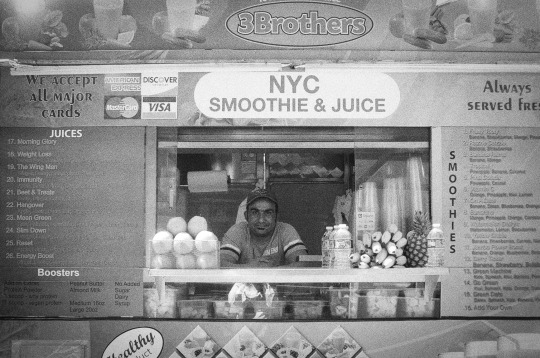
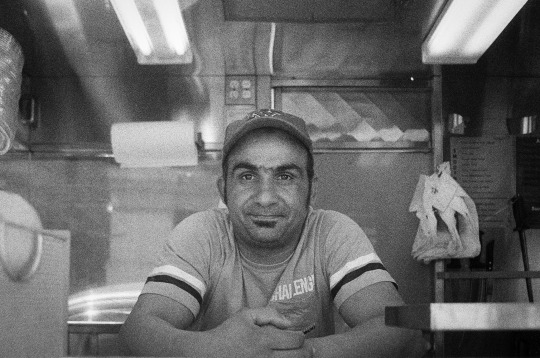
What’s your name?
Ibrahim Ahmed
How long have you been working here?
I started here in 2010. I stopped working in the last year, I just started working again today, I just came back today.
Why did you stop for a year?
Ah, it had something to do with my kids and I started studying in school and I had no time for that.
Oh wow, that’s great! What school are you attending?
Southern New Hampshire University. It’s online.
What are you studying?
Computer science.
Wow that’s great! So why did you pick Wall Street, what does Wall Street mean to you?
So… yeah… it was busy here, it was before… before Deutsch Bank and a lot of places are empty right now. But before COVID there was a lot of traffic here.
Totally. Did you have to get your license back in order to come back?
Yea, I have a license I have with a permit right here in front of the car. But once you get a permit it doesn’t matter, you can work anywhere.
As long as you don’t have competition? Like nobody wants to fight you for the spot?
[Laughs] Right exactly.
How many years do you have left in school? What do you hope to do when you finish?
I just finished this semester May 2nd. I still have more to go but when I finish I will work in something remotely or something where I can stay at home…
I was wondering where you’re from originally?
Egypt.
When did you come to USA?
I came in 2008.
Wow so you were fast with getting your truck on the road!
Yea, when I came here my uncle worked here in the street, so I worked with him in the same business for two years. Then I made my own truck with a friend, so that’s why you find it says “3 Brothers”, we three shared for this car.
Okay, last question! When are you hoping to finish working on Wall Street? As in, do you have an end date goal that you’d like to be out of here by?
Actually, for now no, because I have a kid in the school, I have four kids, so I have to work to support them and to pay bills and support him in school… it’s too many things so, I didn’t have a plan when I finish.. so yeah.
Thank you so much for your time today, I really appreciate you! Is it okay if I can take your photo for my class?
Yes, of course!
0 notes
Text
Wall Street Photos
I missed the day of the field trip, but I went to Wall Street on my own during a sleepy Monday, late morning (about 11am). Instead of capturing the architecture, I tried to capture more how people interact with the space. I was dismayed to find that there weren't many people at all, and there the little that there were, were all tourists! Wall Street is truly a shadow of what it used to be.
I changed my approach to include not only tourists, but some of the "workers of Wall Street"; those who work the street. I shot this on Ilford HP5 film, and when my film ran out, I used my iPhone.
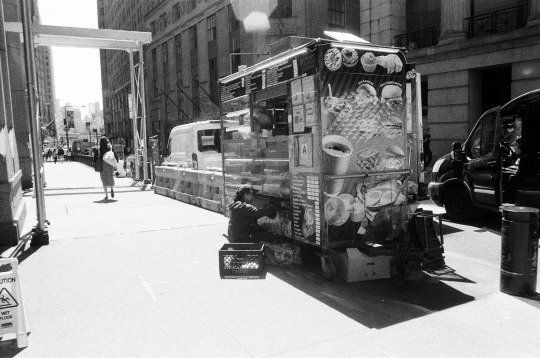
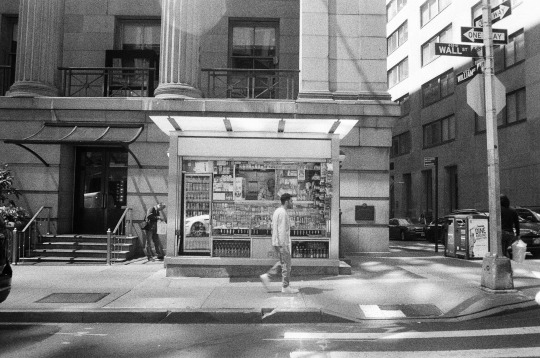
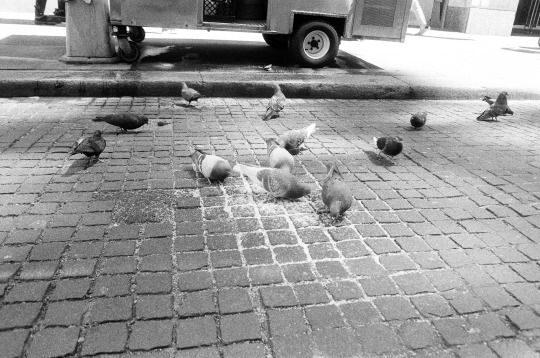
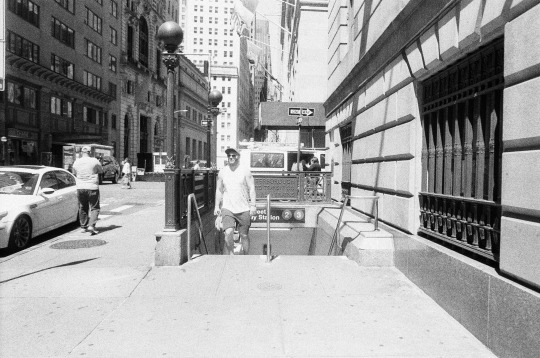

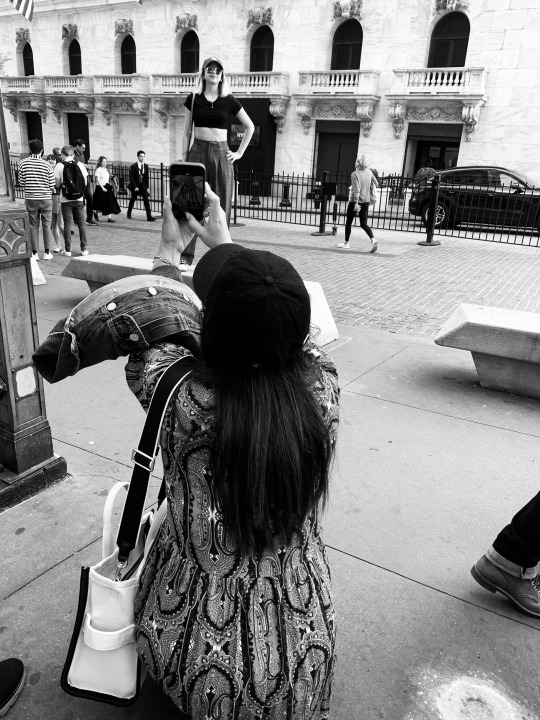
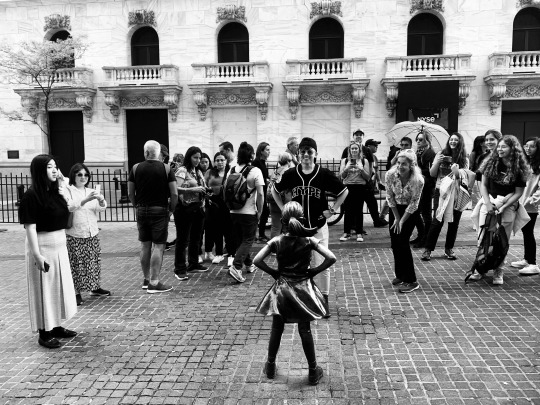
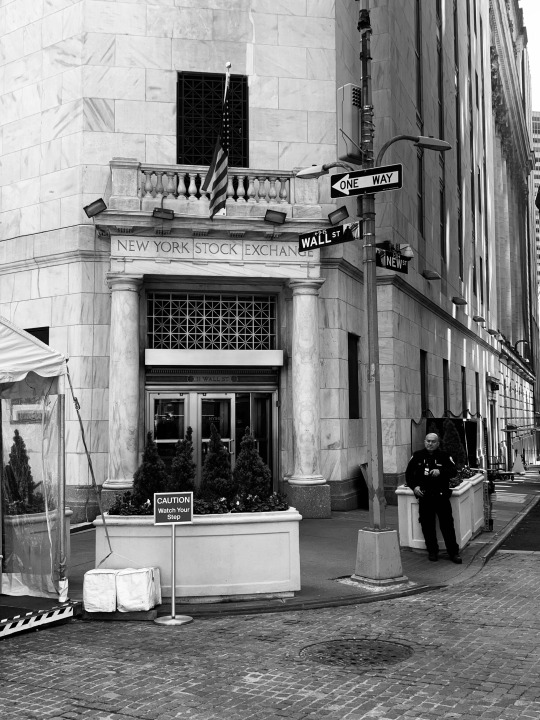
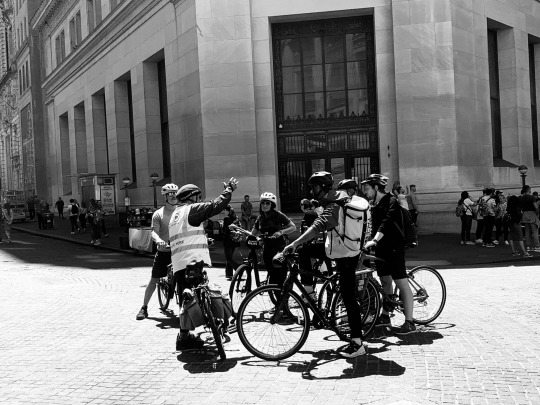

0 notes
Text
Final Project Field Plan - HUN 191

I plan to photograph the region by walking through it systematically over the course of six weeks, breaking down the area I plan to cover each week by region. I will start from the North and work my way South—I usually get more caught up in the South, as the neighborhood becomes more lively, and I prefer to have more time for that at the end. I plan to photograph the buildings/architecture of the neighborhood, as I feel this will be important to document as time/gentrification will inevitably change the look of these neighborhoods. For this same reason, I plan to document the people of the neighborhood as well—the residents, but also some of the locally famous shop owners and street personalities. The last component I plan to photograph are the parks and train stations within 10459, making observation as to how these public spaces are utilized by the local community. I do not plan to photograph the schools.
I will be transparent and say, as this project is rooted in street photography I don’t have a set goal as to how I want the project to look in the end. My goal is to hold myself to the schedule of showing up, being present, making connections and allowing things to flow naturally within the 6 week timeframe. I expect that the people I encounter along the way will be what makes the project special.
Week 1: April 3rd – 9th *Easter Weekend
Areas of Focus: Starlight Park to Freeman Street (pictured below)

Definite Photograph Goals:
Starlight Park, Freeman Street Station
People exiting churches after Easter Sunday services on April 9th.
There is a cluster of three Christian Churches in the triangle block of Jennings St., Freeman St., and West Farms Blvd.
Week 2: April 10th – 16th *Wedding Weekend, Spring Break Week
*** I have a weekend to attend this Sunday so I need to format my shooting schedule accordingly. I also start a new job this week. I will be shooting early mornings during the week before work, and Saturday.
Areas of Focus: Freeman Ave (North Boundary) to 167th St. (South Boundary), Whitlock Ave. (East Boundary), Union Ave. (West Boundary) – see below.
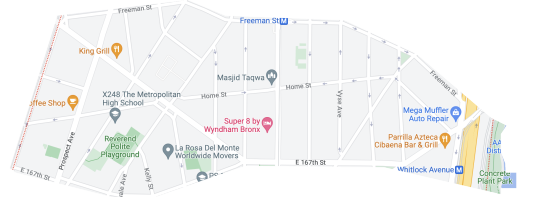
Definite Photograph Goals:
Whitlock Ave. Station
Paradise on Earth Community Garden @ 1106 Fox St.
Field of Dreams Park @ 167 & Southern Blvd.
Concrete Plant Park (not technically in the 10459 zip code but just on the other line of the border. I am choosing to include this because without a doubt it is a huge part of the neighborhood—no other “zip code” has direct access to it.
Whitlock Avenue Bridge, also known in popular culture for a famous photograph Martha Cooper took of it in the 70’s.
Bryant Triangle—it’s known as a junkie hangout but it’s undeniably part of the neighborhood that everyone is aware of and not something to be overlooked. Also, lots of pigeon feeding goes on here.
Reverend Polite Playground. Big during baseball/softball season.
Week 3 & 4: April 17th – April 30th
Areas of Focus: 167th St (North Boundary) to 163rd St. (South Boundary), Whitlock Ave./Bruckner Blvd. (East Boundary), Tinton Ave./Union Ave. (West Boundary) – see below.
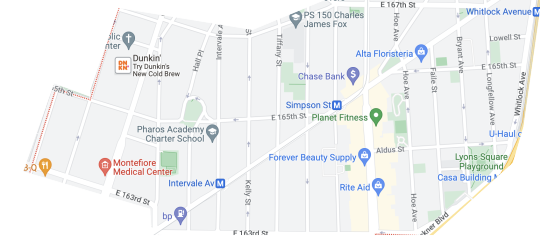
Definite Photographic Goals:
Simpson Street Station, Intervale Ave. Station, Hunts Point Station
Southern Blvd Shopping District, Street Vendors, notable shops
Davidson Houses, NYCHA
Basil Behagen Playground, Horseshoe Playground, Lyons Square Playground, Printer’s Park
Big Pun Mural
Tats Cru Bronx Mural, present-day graffiti tour point
Hoe Garden
20/20 Deli
Week 5: May 1st – May 7th
Areas of Focus: 163rd St (North Boundary) to Longwood Ave. (South Boundary), Bruckner Blvd. (East Boundary), Tinton Ave. (West Boundary) – see below.

Definite Photographic Goals:
Bill Rainey Park
Prospect Ave. Station, Longwood Ave. Station
John Ahearn sculptures
Salsa music store on Longwood Ave
Week 6: May 8th – 14th
If there were any areas I needed to revisit, this is my time to do so.
Making a final edit to the photos taken—Ideally I would love to make a zine out of this material but that may be ambitious depending on my workload from class. Plan B would be to As of right now, there is no Plan B. I will discuss with Prof. S if my presentation plan does not materialize as I’d like. I’ll know whether this is feasible by Week 5.
0 notes
Text
A Response-- Let Us Now Praise Famous Men / Hale County, This Morning, This Evening
Let Us Now Praise Famous Men, first published in 1941 by photographer Walker Evans and journalist James Agee, has become an American classic, noted for how the book, at time of publication went against norms of documentation and traditional reporting. Up until this point, photos were generally regarded as accompanying text, which was given the highest importance in books. This publication broke norms by essentially publishing two books in one, where the photos (taken by Walker Evans) stood on their own, without the company of text to overtake it. The photos were also published first in the book, thereby establishing their importance over the text (written by James Agee) that mark the second half of the book.
The documentation of the reality of the sharecroppers is striking. They are white, impoverished families with gaunt faces, hardened with struggle, living in bare shacks. Black and white photography captures the essence of its subjects, and in this case serves to stress the brutal reality of these sharecroppers. Where the project lacks is in its depiction-- only white families are shown, and at the time of these photos, 75% of the Hale County population was black. I would like to think of this subversive racism behind the project as not completely intentional-- black people even then understood the power of the camera, and arguably, the implication of white people behind it, and ran from them. Agee was quoted as saying, "I notice how much slower white people are to catch on than negroes, who understand the meaning of a camera, a weapon, a stealer of images and souls...". That being said, the project shows a truth of American History, albeit a staunchly curated, and therefor, relative truth. This phenomenon best explained by Richard Avedon, "There is no truth in photography. There is no truth about anyone’s person... portraits are much more about me than they are about the people I photograph... The photographer has complete control, the issue is a moral one and it is complicated."
The overall tone of the project invites feelings of despair, sadness, the hopelessness of oppressive, crushing poverty. The book itself is a beautiful work of art that I personally feel, for its time, was way ahead of itself as a photo book with reference to the professional, clean layout of the photos. The book can stand to compete and excel beyond photo books published even today.
Hale County, This Morning, This Evening by Ramell Ross captures the same geographic area of America and Alabama state, but in a completely different manner, with a completely different demographic-- black people. Watching the documentary, I felt Ross was very successful in removing his presence, and therefor the personal narrative, of the photographer/filmmaker almost entirely. Some of this, I believe, can be attributed to the amount of time Ross spent living in Hale County-- 3 years, versus 8 weeks by Evans and Agee. In this way he eludes a shortcoming of Let Us Now Praise Famous Men, because the subjects are not "othered" by the outsider photographer (and narrator); they are not props. Ross is successful in capturing the "historically elusive" black population because of his access as a black man himself, his natural integration into the community through his years spent there. Scott L. Matthews, professor of history at Florida State University, says Ross's work "brings the humanity of Hale County's people into the light... they appear at a distance... absorbed in quotidian experience and not captured by the camera for the viewer's pleasure or project. Ross presents them with sacrificial care, allowing them, and not the artist, to author their identities." Both projects have in common that they use untraditional ways to document Hale County, and have various successes in doing so. Ross's untraditional documentary uses almost a stream of conscious type of observation, comprised primarily of "b-roll" footage, and yet the film is not lacking in contex or journalistic quality-- the viewer is able to take away very much about the reality of the people of Hale County. The b-roll, stream of conscious approach captures the essence of real life-- it mostly happens in small moments, mundanity, a buildup of the cumulation of everyday life. It doesn't happen in these grand moments-- a powerful snapshot that captures an all encompassing truth in a fraction of a second.
I had a greater appreciation for Hale County, This Morning, This Evening. As a work of journalistic documentary, I felt it was more successful of a truer depiction of life for the people in Hale County. While it also lacks in depicting of a population (in this case, the minority white population), and admittedly has the advantage of motion picture to provide a more realistic account, I overall found it more interesting and exciting to see a typically ignored population be depicted. I also found it very moving that it didn't portray these people as victims, or through a lens of despair, as Let Us Now Praise Famous Men did. It was just real-- it made no statements, and it took its time.
0 notes
Text
Final Project Progress - Week 5





Week 5, Roll 1 Highlights
Technical Notes:
This was actually the second building inspection that I had gone to, as the first one I made the unfortunate mistake of improperly loading my film and capturing nothing. Insurance reasons prevented me from going up in the "basket" with the rest of the contractors. The second inspection was scheduled two hours earlier than the first one I'd gone to and due to that I missed some of the beautiful higher contrast sunset lighting I thought I had gotten the first time (the building is along the Hudson River).
Ultimately I may only use two photos from here for the final portfolio.
Shot using Kodak TMax400, developed normally with HC110(b).
0 notes
Text
Final Project Progress - Week 4
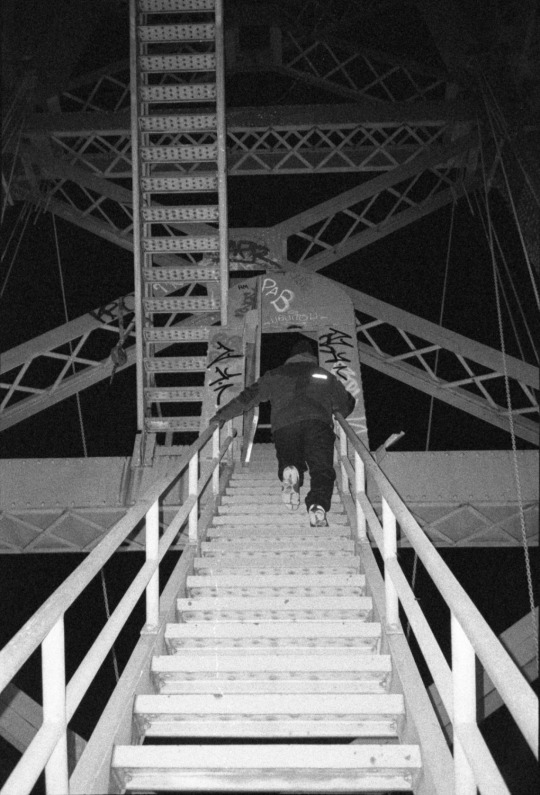
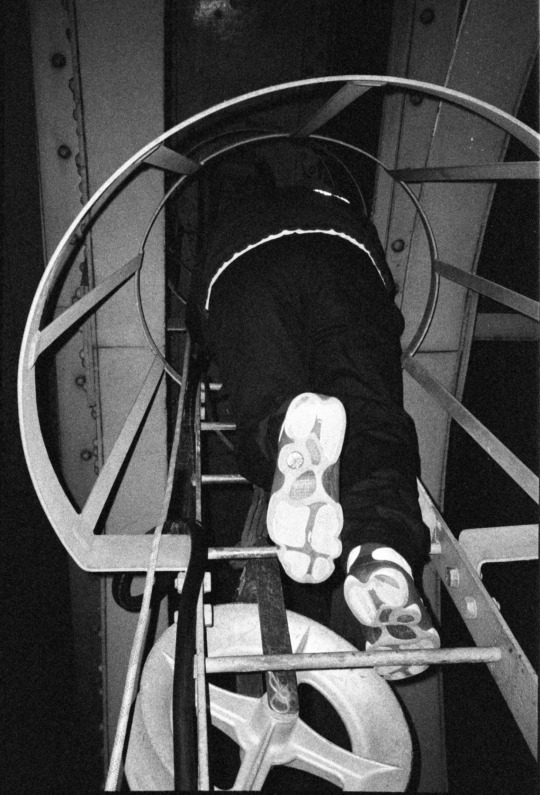


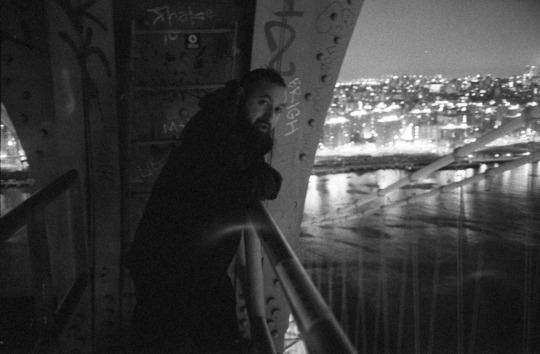


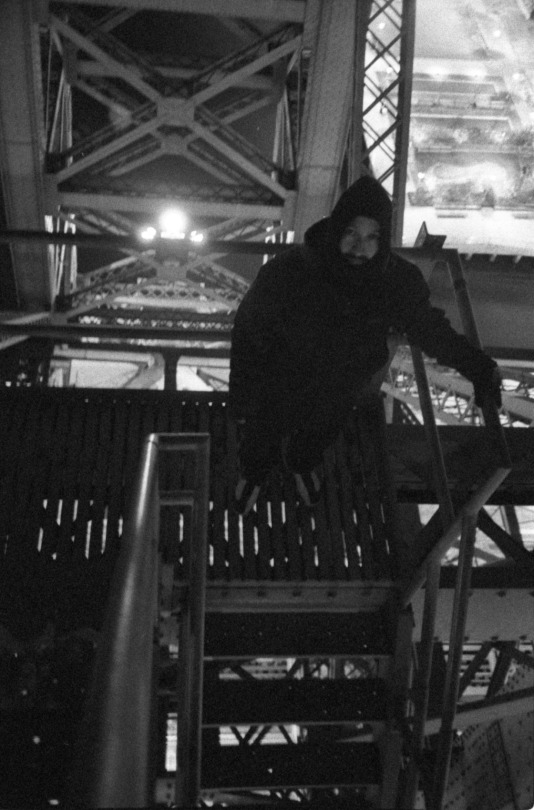

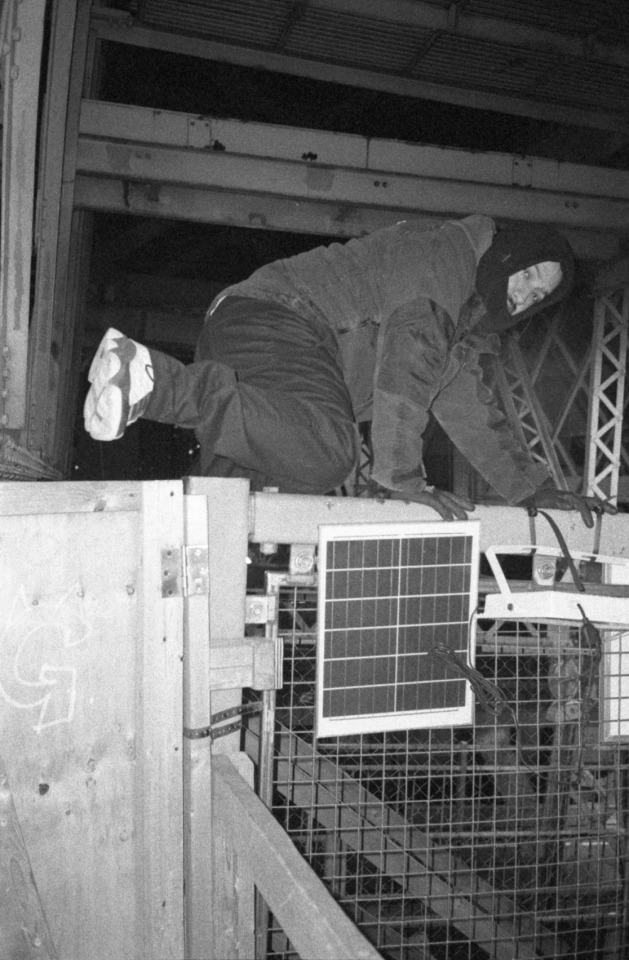
Week 4, Roll 1 & 2 Highlights
Technical Notes:
We took off Week 3, originally scheduled to climb the bridge, because it was freezing out and we were both unmotivated. The perfect night came a week later and it was unnaturally balmy for this time of year. It was one of those nights where you just feel it, that everything is going to go perfectly. So we took some whisky shots and made our way over to the bridge and found the entry door to the ascending stairs sprung wide open-- this is an unusual occurrence. Feeling confident that fate was on our side we went up confidently and slowly, taking pictures the entire way up and down.
One unfortunate thing that did occur was the Pentax camera freezing. It was too cold for it to operate and the shutter would freeze shut after one capture. If I warmed it against my body and sacrificed a frame it would work again but this proved to be tedious and time consuming so I resolved to ditch it along with the tripod, and shot exclusively on my Olympus Stylus Epic point and shoot camera. I held my breath and tried my best to stay as still as possible for the shots without flash. Overall I'm very happy with the results and the focus, given the circumstances.
All shot on Kodak TMax3200, pushed a stop to 1600iso, developed HC110(b) normally at 1600.
1 note
·
View note
Text
Final Project Progress - Week 2

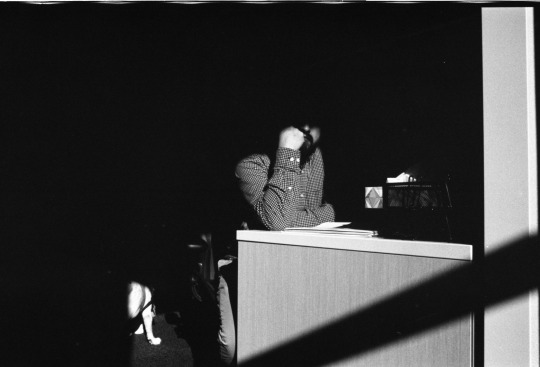

Week 2, Roll 1 Highlights - Kodak TMax400, shot early morning

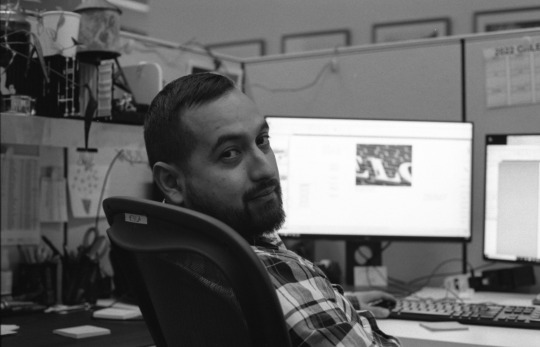

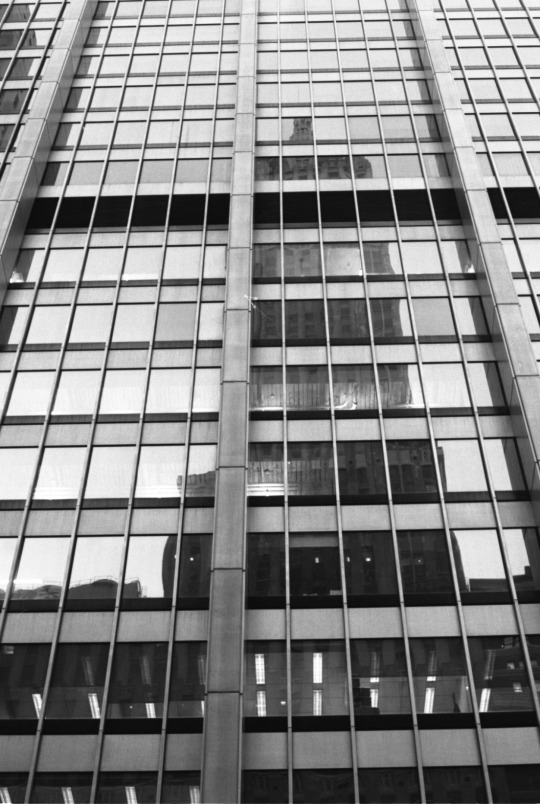
Week 2, Roll 2 - Kodak TMax 400, shot evening, separate day.
Technical Notes:
Remembered how much I love TMax400 with these shots. Struggled to find a more interesting POV for this section of photos. The most interesting shots have little to do with the subject matter and won't be used in the final presentation.
I do appreciate these photos from a photojournalistic standpoint but struggling to see if and where they fit in the final portfolio presentation being that it's limited to fewer prints than I feel comfortable with to fully convey a story.
All were shot using Kodak TMax400, developed normally with HC110(b).
0 notes
Text
Final Project Progress - Week 1
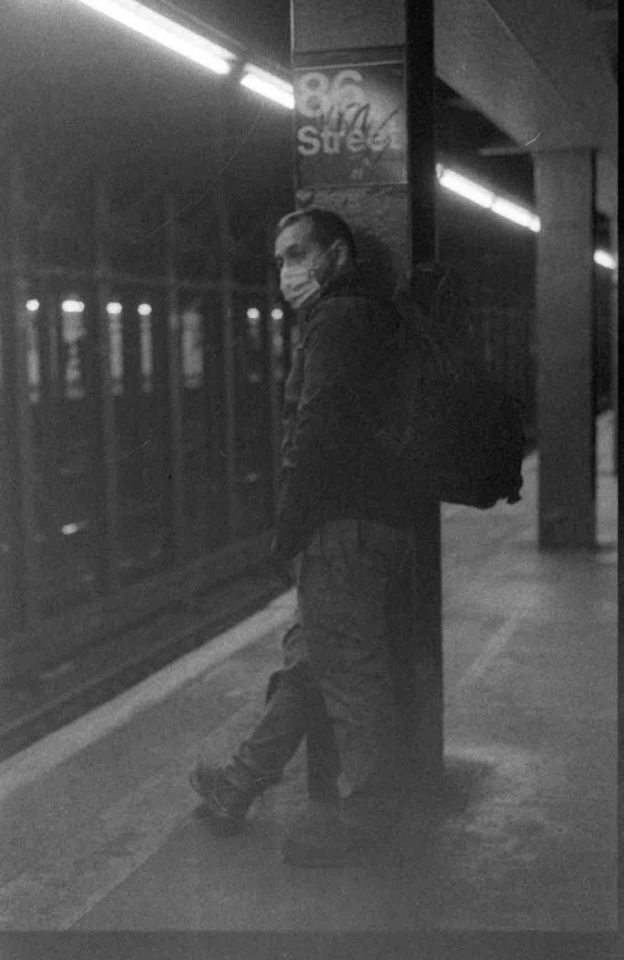
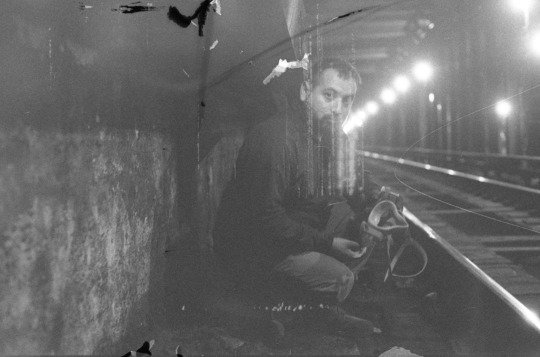
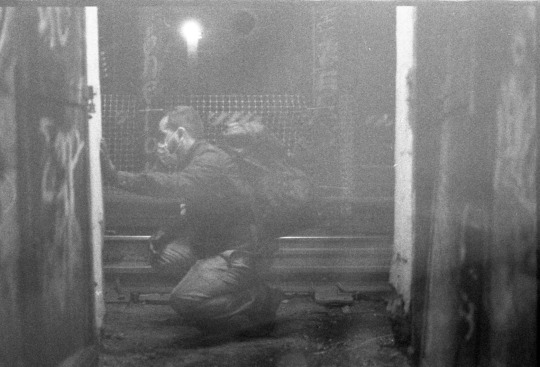

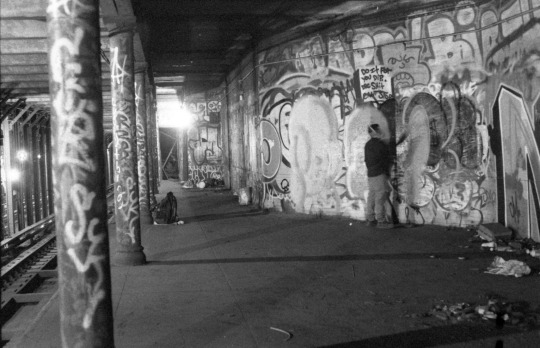

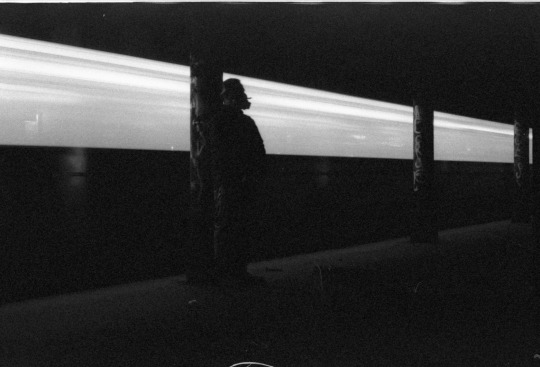
Roll 1 Highlights
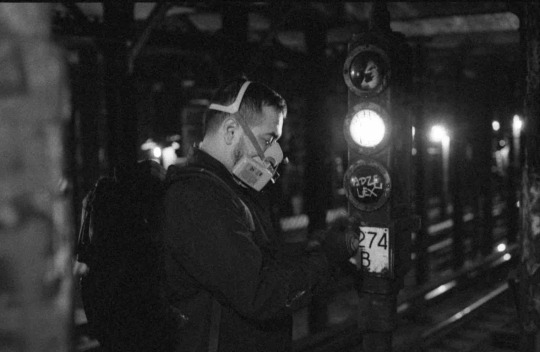

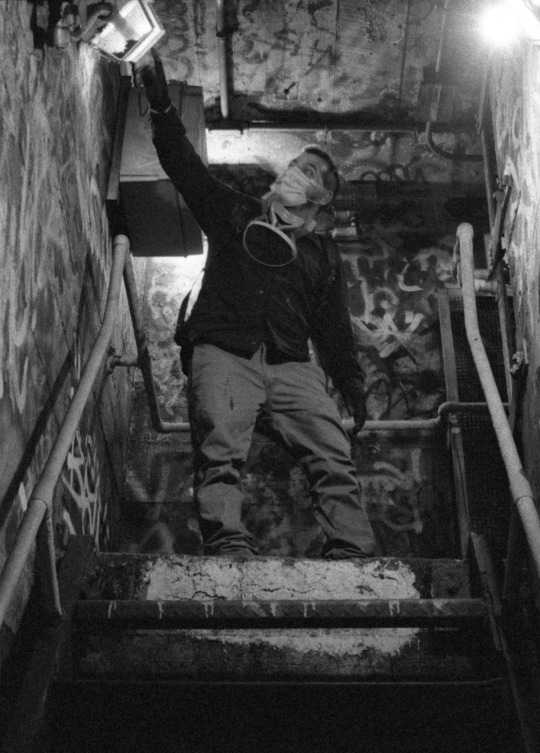

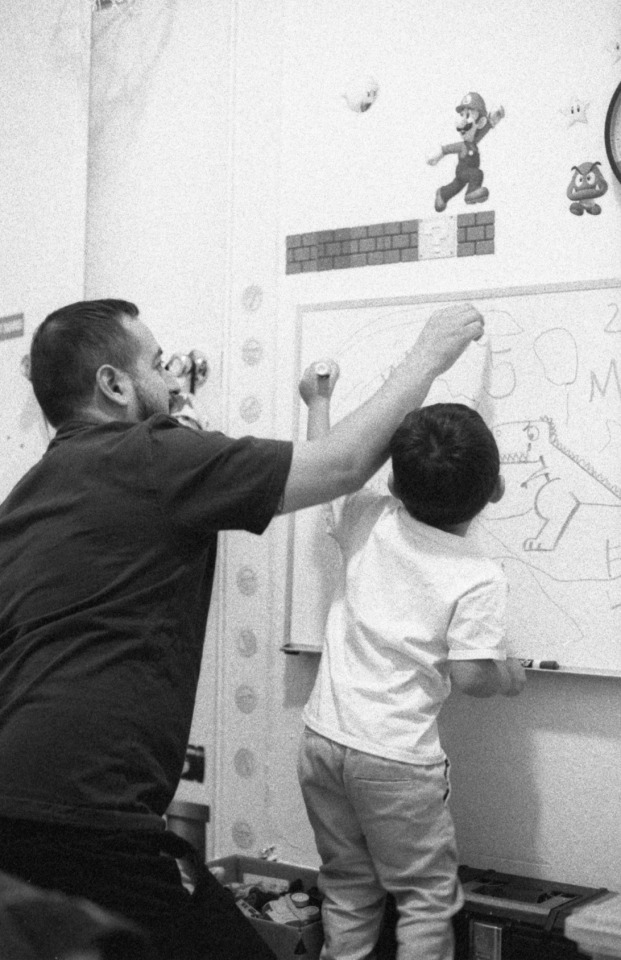


Roll 2 Highlights

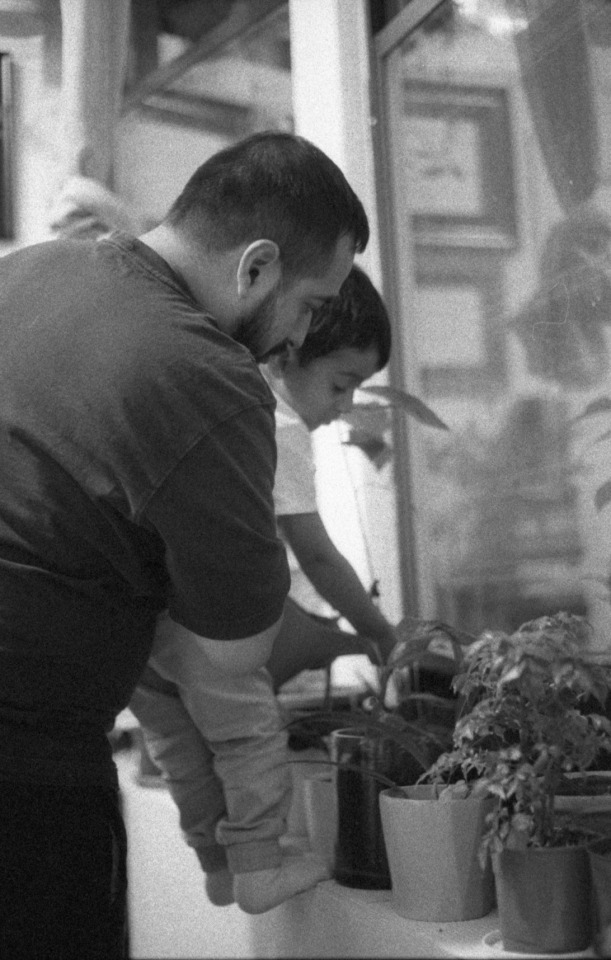

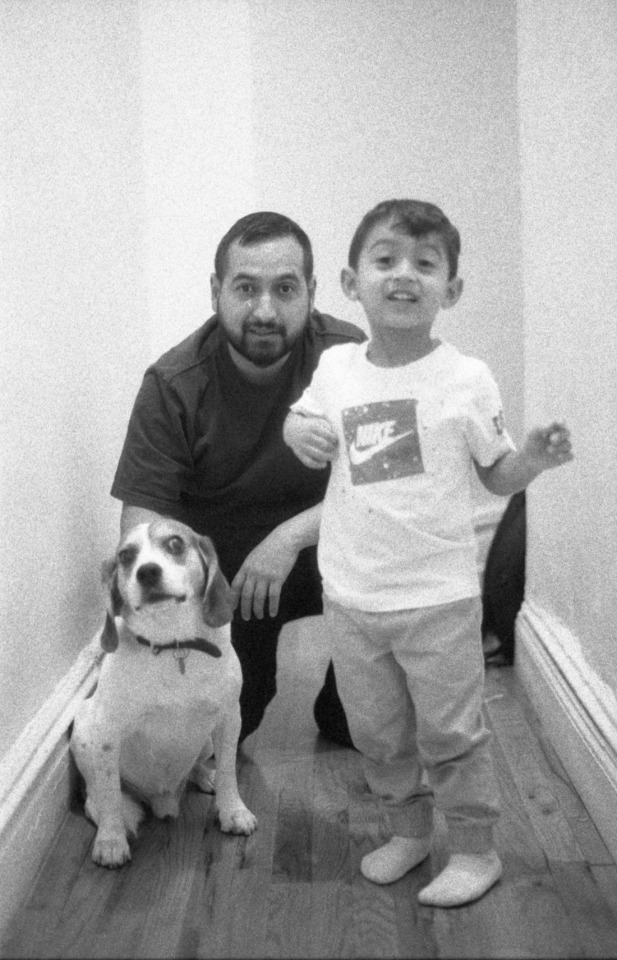



Roll 3 Highlights
Technical Notes:
Photos above are of "Action 1" having taken place in a subway tunnel in Upper Manhattan. The first roll was ruined during development due to poor decision making resulting in carelessness, but it created some effects on the negatives that were interesting. Not all of the negatives were developed equally, so some shots that had the potential to be very good didn't come to fruition, and the shots that.I did like, even if they were interesting, I felt hesitant to use them in the project because they felt more like "art" and less like "documentary".
The second roll was divided between "Action 1" and shots at home with "F" and his son. His wife declined to be in the photos. His son loved the camera and it ended up being a lot of fun, as well as being quite touching to have been entrusted with capturing such vulnerable and intimate moments between a father and son.
Roll 3 was shot in the home. All rolls were developed normally using HC110(b), all were shot using Kodak TMax 3200.
0 notes
Text
Final Project Field Plan
Goals/ Objective:
This photo essay is a branch off of a personal project I have already been working on this past year about native New Yorkers that give and are part of the “street culture” of New York City. The project aims to highlight the native New Yorkers (that I personally know) that make this city the cultural epicenter that it is. By being a part of their respective “scenes” or subcultures, these people by proxy inspire tourists worldwide to flock to New York City with the goal to take part and meet others of these urban subcultures. My friends are the people that inspire other skateboarders, BMX riders, alleycat racers, urban explorers, or graffiti artists to come here and be recognized on a global scale, as New York City is a scene that everyone from around the world pays attention to get a pulse on what’s happening in the scene, and the direction it’s going.
That being said, the premise of the project was to remove people out of the environments of their respective subcultures (the skatepark, a subway tunnel, the stairs of Union Square) and take their portraits in more intimate environments such as their home, their art studios, a place sentimental to them, etc. Essentially stripping them of their “titles” and just photographing them as “normal people”, posing questions of identity. Are these people as “relevant” in their “normal lives”? Do these portraits have the same ability to captivate the viewer as if they were viewing a photo of this person within the context of “Thrasher” magazine, or across the finish line, or in a graffiti zine, or at their art exhibition? What is the actual identity of people whose lines are blurred between “just a hobby” and complete personal identity?
For my personal project, I seek to go a bit deeper than a simple portrait, and instead create a photo essay about “F”: a good friend of mine, a father, a husband, a son, an architect, a graffiti writer, a New Yorker. Specifically I seek to examine in greater detail this division of identities and the intricate balancing act of them all, as only some overlap exists between certain identities, while others are fiercely compartmentalized and protected. I plan to continue examining how “F” gives to “street culture” of New York City by working on the buildings that create our visual landscape while contrastingly writing graffiti on separate architecture, and finally, what he takes home from it all at the end of the day, if anything at all.
Tentative Field Plan from November 1st – December 12th.
Week 1: 11/1 – 11/7
Meet with “F” in his home located in Harlem.
Portraits of “F” and nuclear family (son and wife).
Photography Direction: home life taking place in the living room and kitchen.
Map out the specifics of future “actions” in the coming weekends and making equipment decisions for future “kits”.
Supplies: Pentax K-1000 and 3200 speed film (the apartment does not receive much direct sunlight and I am expecting to meet more towards evening time).
Week 2: 11/8 – 11/14
Develop photos from week prior, begin making selections and edits.
“Action” 1
Tentative date: weekend of 11/11, 11/12, 11/13. Midnight hours.
Location: NYC subway tunnels, exact location undetermined
Vision for graffiti; undetermined
Photography Direction: action shots using flash, long exposure atmospheric shots, “double” exposure long exposures devoting half the exposure time to portraiture and the other half to action, normal portrait shots (flash use TBD depending on lighting), photos entering and exiting (safety permitting), photos of preparation and clean up.
Supplies Required: Spraypaint (amount and colors TBD), Backpack, face masks, respirators, gloves, Pentax K1000 camera, tripod, fill flash (need to request from department), 2 rolls of Kodak TMax 3200 film.
Week 3: 11/15 – 11/21
Develop photos from week prior, continue making selections and edits.
“Action” 2
Tentative Date: Weekend of 11/18, 11/19, 11/20. Midnight Hours.
Climbing atop the Williamsburg Bridge
Weather dependent ***
Plan B- Tunnel Part 2 (specifics TBD)
Required materials will be same as “Action” 1
Photography Direction: long exposures of architecture/infrastructure, long exposures of the cityscape in the distance most likely using bracketing techniques. Closeup portraiture of “F” against the backdrop of the beams/ infrastructure (hoping to have sufficient light to not require flash but will use if necessary), portraits from farther back showing full body and location (long exposure), portraits of “F” with cityscape background (long exposure), action shots ascending/descending the bridge (no flash, lighting should be sufficient in the lower parts), the walk on the way to and from the action (before and after), quick action shots of “F” writing graffiti.
Graffiti not intended to be as involved as “Action” 1. It functions on this occasion more so to simply mark, “I was here”.
Supplies Required: 3 cans of spray paint (colors TBD), backpack, gloves, face masks, Pentax K1000 camera, tripod, fill flash, 2 rolls of32800 speed film (Kodak TMax).
Week 4: 11/22 – 11/28
Focus on continued development of photos and heavy focus on printing this week.
Thanksgiving Week **
Not much time for shooting this week due to holiday.
Will visit “F” and nuclear family in their Harlem home briefly over the weekend to spend some time, give thanks, and shoot minimally. I do not plan to use more than half a roll of 800 speed film.
Required supplies: 800 speed film, Pentax K1000.
Week 5: 11/29 – 12/5
Friendsgiving
Location: New Jersey
Date: Saturday, 12/3/22.
Photography Direction: Portraits of “F”, nuclear family, and close friends. Photos are planned to be a more intimate view into the personal aspect of his life and the bond shared amongst friends, and the love and warmth created around sharing a meal together. Atmospheric photos of the table settings and layout, the food and drink provided, and the celebration as the night goes on.
Required Materials: 800 speed film and fill flash (use is light dependent— some parts of the house have sufficient lighting and others do not).
Week 6: 12/6 – 12/12
Continued development and selection making and editing of photos. More final edits pulling the entire project together.
Office Visit scheduled for December 10th, Saturday.
Will be receiving tour of “F” architectural firm.
Specific name of firm will be purposefully excluded from the documentation.
Briefs of current projects under works
Visit of one work site after office visit
“F” to show the work underway personally from the ground level; entry onto lifts/ scaffolding not permitted.
Conversation with “F” as to his interpretation of the work he does during weekdays versus the work he does for hobby and how they interrelate.
Photography Direction: Atmospheric shot of the office, closer shots of his desk/workstation. Shots of plans, blueprints, computer workstation, materials brought back from site, materials used for building inspections. Pictures of “F” dressed for a day of work. Full body shots of him leaning against his desk. Close up portraits sitting in his work chair, him answering emails. Work site direction include taking photos of the work in general, and perhaps a photo making a physical representation as to the work being done (a pointed finger, a closeup detail of façade if possible). Work site specifics TBD depending on access.
0 notes
Text
Class Notes - 11/1/22
Bruce Davidson:
Sometimes asked permission, sometimes complimented after the fact
Shot Subway using Kodachrome 64 film, slow film, high contrast. Creates dense shadows.
Used flash sometimes, other times no flash
Used lens filters at times
Brooklyn Gang, Jokers-- used 100W bulb for the shots under the Coney Island Boardwalk
"Record them, show them as they are"
Magnum photos has his photos on display
Research:
Julio Mitchel
Susan Marsalas - Carnival Strippers
Gary Whittaker - street photographer
Bill Cunningham - Fashion NYT, rode around the city on bike and shot "neighborhood fashion" photos.
0 notes
Text
Class Notes - 10/25/22
Oral Presentation:
November 22nd
Mary Ellen Mark
10-12 minute oral presentation due
F Stops:
1.0 - 1.2 - 1.4 - 2 - 2.8 - 4 - 5.6 - 8 - 11 - 16 - 22 - 32 - 45 - 64
Shutter Speeds:
BULB - 1s - 1/2s - 1/4s - 1/8s - 1/15s - 1/30s - 1/60s - 1/125s - 1/250s - 1/500s - 1/1000s
Jerry Uellsman:
silk screen reminiscent darkroom printing style, photo montage
Using a red filter in the enlarger, the red does not expose any light, allowing one the time to line up negatives and create custom shaped doge/burning tools to "montage" photos on one silver paper.
0 notes
Text
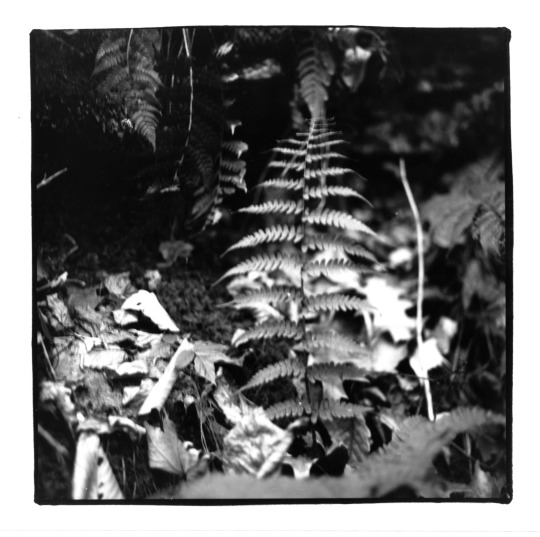
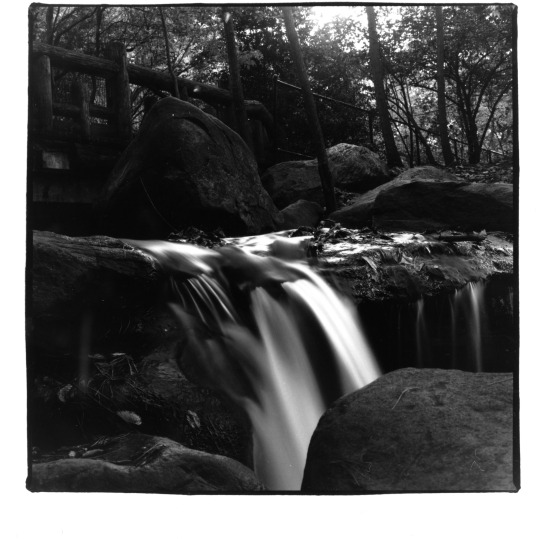
Low Contrast
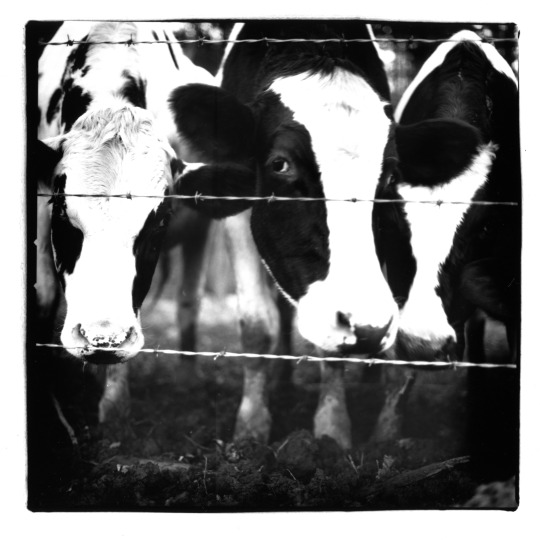

Medium Contrast
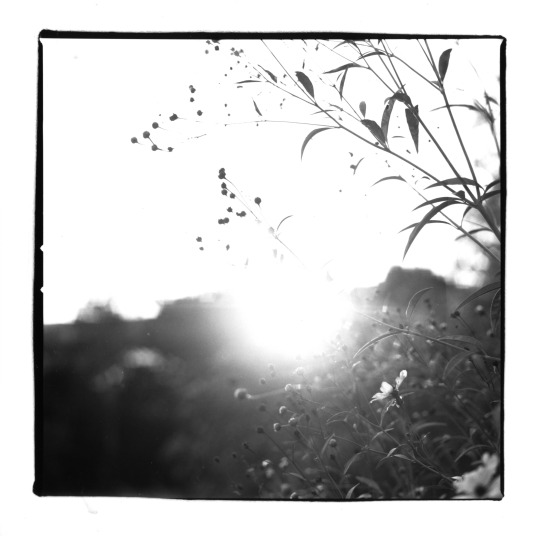

High Contrast
Assignment 2- Wood, Water, Stone, Flora
The Wood, Water, Stone, Flora assignment requires that you photograph a variety of natural subjects at 3 different levels of contrast, high, medium and low using one film type. Ilford FP4 iso 125
The final assignment should include a minimum of 4 images, one from each situation (High medium and low) and one of your choice.
Use a different roll of film for each situation. Use the same film type for all the contrast situations
Use of a tripod and cable release is REQUIRED for this assignment.
Control the contrast in each situation through development
Use the manufacturers recommended time for development as your N development time. (for normal contrast). N+ add 40% to development time (use this for low contrast). N- subtract 20% (for high contrast)
Use the same developer, dilution and temperature for all 3 rolls. The only variable should be the development time.
Technical Notes:
This was definitely the most challenging assignment of the semester.
I decided to spend a weekend upstate in the town of Catskill to get the shots for this assignment. I had tried to take some nature shots locally in Prospect Park but felt disinterested.
I shot exclusively on medium format because I thought a 24 exposure roll of 35mm filter would be too much to try and get through when I know that I usually have a hard time finding interest in landscape photography. The medium format decision resulted in using a Hasselblad 6x6 camera-- I'd never shot medium format before, never used a Hasselblad, never shot square-- there was a lot going on. One of the first days trying to figure out the Hasselblad I actually got motion sick after using it and being almost upside down trying to get this shot in the middle of the freezing cold creek for almost an hour. I stepped in cow manure and one cow licked me and the camera so hard it almost fell and I became terrified I'd owe the school thousands of dollars. My shutter cable kept popping out of the camera even though I was sure I screwed it in properly. It was also pretty stressful chasing sunlight (or lack thereof) all day, as this assignment taught me that those perfect lighting moments go as quickly as they come. I also found it difficult to understand what might translate as normal or high contrast on black and white film as I looked at the world in color and many of the shots didn't come out as I had planned because I wasn't expecting the high contrast of the film. I had a hard time trying to train my mind to look at everything tonally. After all these shots, the darkroom came with its own challenges and was kind of a nightmare until the very end when I finally came to understand how to properly use filters and split tone print. By the end of it all I understood why we had been given this assignment and I am very grateful for it-- I was able to take away a lot of new learned skills and knowledge.
0 notes

